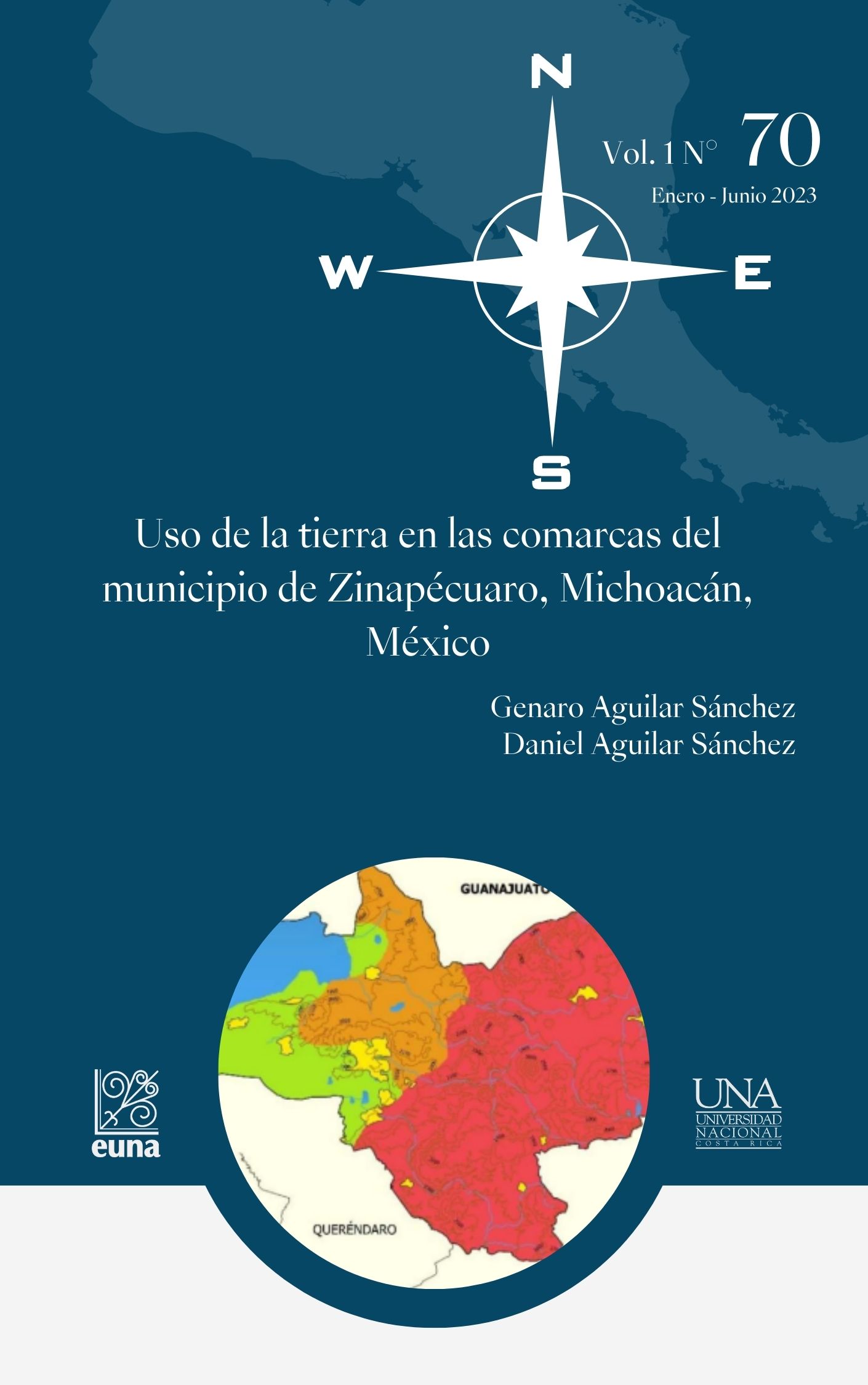Land use in the comarcas of the municipality of Zinapecuaro, Michoacan, Mexico
DOI:
https://doi.org/10.15359/rgac.70-1.9Keywords:
Landscapes, Agricultural production, Land class, DegradationAbstract
This research aims to identify the landscapes that are formed in the municipality of Zinapecuaro, at a scale of 1: 250,000; characterize the appropriation of the landscape made by the inhabitants through its use and propose a better use of differentiated landscapes. The methodology of differen- tiating the territory through complex Towns and Regions is applied and, within them, field work is carried out by comparing their current use with that recommended by the FAO, in its agroecological zoning proposal. It is found that in the municipality of Zinapecuaro there are 4 complex Comarcas and each one of them has several classes of land. In most of the Comarcas and classes of land, the current use, agricultural and livestock, does not correspond to what is recommended by the FAO, since they should have a forestry and conservation use. Due to the above, the change of use of forest land to agriculture and livestock must be controlled, to stop the degradation of soil and vegetation.
References
Aguirre, R. (2010). Unidades campesinas de paisaje: estudio de caso en el ejido Nexpa, MichoacánMorelia, Michoacán. /IPN. [Tesis de Maes- tría en Geografía]. CIGA-UNAM.
Bocco, G. Mendoza, M. Priego, A. & Burgos, A. (2010). La cartografía de los sis- temas naturales como base geográfica para la planeación territorial. CIGA.
Chiappy, G. (2000). Caracterización de los paisajes terrestres actuales de la península de Yucatán. Investigaciones Geográficas. (42) 28–39.
Comisión Nacional Forestal. [CONAFOR]. (2007). Manual básico para el Or- denamiento Territorial Comunitario (OTC). Comisiona Nacional Forestal.
De Fuentes, K. (2009). Análisis del Paisaje y Estudio de la Percepciones ambientales en la Congregación Tapachapan, Municipio de Coate- pec, Veracruz. Instituto de Ecologia A.C.
Escalante, R. (2006). Desarrollo rural, regional y medio ambiente. ECO- NOMÍA/UNAM. 3 (8), 70-94.
Escudero, E. (2004). Investigación Cualitativa e Investigación Cuantitati- va: Un punto de vista. Revista Enfoques Educacionales. 6 (1),11-18.
Organización para la Agriclurura y la Alimentación. (1997). Boletìn de suelos de la FAO: Zonificación agro-ecologica. UNESCO.
García, E. (2004). Modificación al Sistema de Clasificación Climática de Köppen (para adaptarlo a las condiciones de la República Mexicana. (5ª ed.). Instituto de Geografía-UNAM.
Instituto Nacional de Estadistica,Geografía e Informatica. (2009). Pron- tuario de información geográfica municipal de los Estados Unidos Mexicanos Zinapécuaro, Michoacán de Ocampo. México.Clave geoestadística 16110. México: INEGI.
López, A. y Aguilar, G. (2018). Unidades de paisaje locales en el noreste de Michoacán, México. Revista Geográfica de América Central. 3 (61E), 157-179. https://doi.org/10.15359/rgac.61-3.9.
Mateo, M. y da Silva, V. (2007). La Geoecología del paisaje como funda- mento para el análisis ambiental. REDE. http://www.revistarede.ufc. br/rede/article/view/5, 77-98.
Mateo, M. (1991). Geoecología de los paisajes. Universidad de los Andes, Facultad de Ciencias Forestales.
Socioterritoriales. 2 (16), 51–81.
Negrete, G. y Bocco, G. (2003). El ordenamiento ecológico comunitario: una alternativa de planeación participativa en el contexto de la polí- tica ambiental de México. Gaceta ecológica. (68) 9-22.
Negrete, G. y Aguilar, E. (2006). Territorios Rurales, Política de Planea- ción y Ordenamiento Ecológico Local-Comunitario en México. En: Anta, S., Arreola, A., González, M. y Acosta, J. (comps.). Semblanza histórica del Ordenamiento Ecológico Territorial, SEMARNAT-INE.
Ojeda, M., León, A., Michael, C., Dunn, C. y Cajuste, B..(2015). Cartografía participativa para el Ordenamiento Territorial Comunitario: el caso del ejido de Santa María Nativitas, Texcoco, Estado de México. En: Sora- ni, V. y M. Alquicira-Arteaga. (Eds.). Perspectivas del ordenamiento territorial ecológico en América y en Europa 213-237.ISLPEP.
Patton, M. (1990). Qualitative Evaluation and Research Methods.Sage Publications.
Perdomo, M. (2007). El problema ambiental: hacia una interacción de las ciencias naturales y sociales. Revista Iberoamericana de educación. 44 (3), 1-11. https://doi.org/10.35362/rie4432243.
Priego, A. (2010). Propuesta para la generación semiautomatizada de uni- dades de paisaje. UNAM.
Ramírez-Sánchez, G, Priego, G. y Manent, B. (2012). Paisajes Físico-Geográ- ficos del estado de Michoacán. CIGA- UNAM. escala 1:250 000. Uni- versidad Nacional Autónoma de México, Campus Morelia, Michoacán.
Rzedowski, J. (2006). Vegetación de México. Limusa.
Salinas, E. (2005). La geografía física y el ordenamiento territorial en cuba. Gaceta ecológica. (76), 35-51.
Santos, M. (2000). La naturaleza del espacio.Ariel.
Sauvé, L. (2000). Para construir un patrimonio de investigación en educa- ción ambiental. Tópicos en educación ambiental. 2 (5), 51–68.
Vargas, G. (1992). Estudio del uso actual y capacidad de uso de la tierra en América Central. Anuario de Estudios Centroamericanos, Universi- dad de Costa Rica. 18 (2), 7-23.
Vidina, A. (1973). Clasificación tipológica de las partes morfológicas de los paisajes de las llanuras. En:. Moscú, Colección de Geografía de los Paisajes 550-601.Editora de la Universidad estatal de Moscú

Published
How to Cite
Issue
Section
License
Proposed policy for journals offering Open Access
Authors publishing their works in the Journal acknowledge and agree to the following terms:
a) Authors retain the copyrights to their works and guarantee the Journal the right to be the first to publish their works, under the Creative Commons License Attribution-NonCommercial-ShareAlike 4.0 International, CC BY-NC-SA 4.0 International (https://creativecommons.org/licenses/by-nc-sa/4.0/deed.es), which allows others to share works upon complying with the acknowledgment of authorship and mention of the Journal as the original publisher of the work.
b) Authors are permitted to separately establish additional agreements for the non-exclusive distribution of the official edition of the work published in the Journal (for example, authors may desire to place the work in an institutional repository or incorporate it into a book that is to published elsewhere) so long they acknowledgment to recognize the Journal as the original publisher. The aforementioned additional agreements must respect the terms of the non-profit character and sharing philosophy of the original license (CC BY-NC-SA 4.0 International, https://creativecommons.org/licenses/by-nc-sa/4.0/deed.es).
c) Authors are encouraged to archive the post-print or editor/PDF version in Open Access repositories.





 REVGEO is licensed under https://creativecommons.org/licenses/by-nc-sa/4.0/deed.es
REVGEO is licensed under https://creativecommons.org/licenses/by-nc-sa/4.0/deed.es
.svg_4.png)

_(1).png)
_(1)_(1)_(1)_1.png)
(2)(1)(1)(1).png)
